| Article ID | Journal | Published Year | Pages | File Type |
|---|---|---|---|---|
| 7285264 | Cognition | 2018 | 9 Pages |
Abstract
In two experiments, we assessed whether infants are able to learn rules predicated on two abstract relations linked by negation: same and different (not same). In an anticipatory looking paradigm, the relation between successive colored geometrical shapes predicted the location where a puppet would appear next. In Experiment 1, 7-month-olds learned and generalized a rule predicated on the relation same, but not a rule predicated on the relation different. Similarly, in Experiment 2, 12-month-olds learned a rule predicated on the relation same-shape, but not a rule predicated on the relation different-shape. Comparing our data with that from previous experiments in the speech domain, we found no effect of age, modality or rule complexity. We conclude that, in the first year of life, infants already possess a representation of the abstract relation same, which serves as input to a rule. In contrast, we find no evidence that they represent the relation different.
Keywords
Related Topics
Life Sciences
Neuroscience
Cognitive Neuroscience
Authors
Jean-Rémy Hochmann, Susan Carey, Jacques Mehler,
